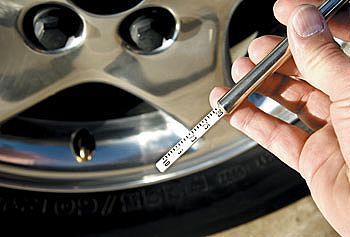

Just recollect the way all of us in India get our air topped up in our tyres. We will normally sit inside the car and allow the mechanic to fill in the air. He is tipped and then we are off till further time we realize that our steering wheel has become a bit hard. We never try to tell him till how much pressure is to be filled and he has no inclination to ask too.
There is lot of thought which goes into recommendation of ideal air pressure by the car manufacturing company. More than necessary air pressure will affect traction between the tyre and the road and will affect the safety of the driver and the drive comfort. Too less an air pressure will mean too much of traction and that may lead to increased tyre wear and also decrease in fuel efficiency. Hence maintaining the right pressure is always important for safety reasons, extending the life of the tyres, overall ride comfort and obtaining better fuel mileage. Proper tyre maintenance includes regularly checking the tyre pressure.
Tyre pressure can be checked by you too. How to you check tyre pressure? Very simple, you just need to follow the following steps:
Invest in a good digital tyre gauge. The old notched tyre gauges of the past have been replaced by more accurate digital versions. You may buy one and keep it in your vehicle.
Locate the recommended tyre pressure for your tyres. This information is spelled out in the vehicle's owner's manual. It is also posted on the driver's side door jam on a sticker. Keep in mind that the sometimes recommended tyre pressure may be different for front tyres and back tyres.
Check tyre pressure in the morning hours. It's recommend to check the tyre pressure in the morning, when the tyres are cold, or half-hour after stopping, since it takes that much time for tyres to cool down after running the vehicle. Best is, before you start for the office just take out your gauge and do a quick check.
How to check the pressure:
- Unscrew the tyre pressure gauge cap and set it aside. Putting it in your shirt pocket is a safe place to keep it while you check the pressure of all your tyres.
- Place the tyre pressure gauge evenly on the tyre's valve stem. This is a pencil-width air nozzle located on the side of the tire. The air starts to escape, causing a hiss sound. Once you firmly press the gauge down on the valve stem, air flow stops and the tyre gauge gives a reading of the tyre pressure. In the older tyre gauges, it blows out the metered needle. On digital ones, the tyre pressure appears electronically on the gauge.
If the tyre pressure on the tires is below that recommended by the vehicle manufacturer, you need to add air to them. For example, say your tyre calls for pounds per square inch (PSI) of 31 and your tire reads 28. You need to inflate the tyre by 3 PSI to bring it up to specification.
Please that for every 3 PSI below specification, you burn 1 percent more fuel (and your tires have an added 10 percent more wear).
As for filling the tyres with air, you have two choices. Buy a portable air compressor you keep at your home or refill the tyres at Petrol pumps.
Please remember that good tyre maintenance begins with regular (at least monthly) checking of the tyre pressure in all four tyres and taking appropriate steps to fill them to recommended specs.
Please remember that good tyre maintenance begins with regular (at least monthly) checking of the tyre pressure in all four tyres and taking appropriate steps to fill them to recommended specs.
No comments:
Post a Comment